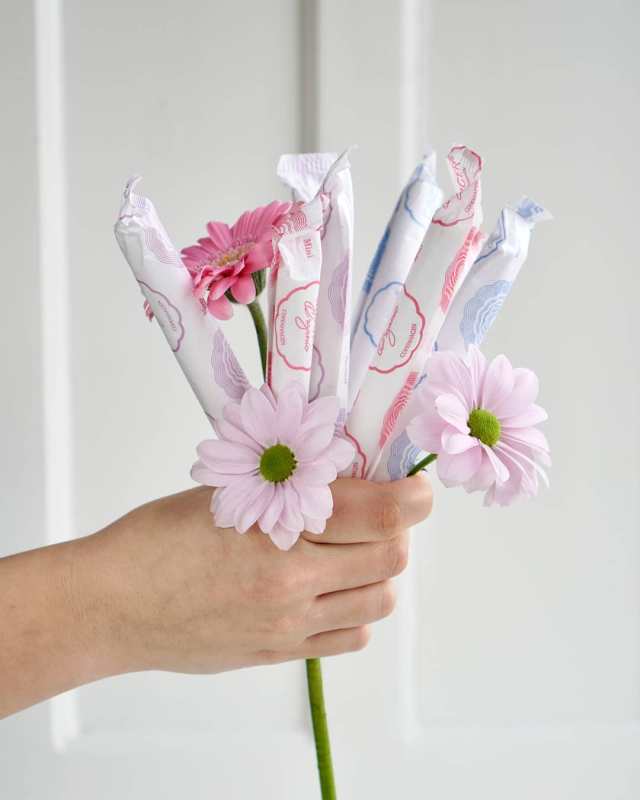Menstrual products like sanitary or menstrual pads, liners and tampons mostly consist of two of the No-No’s for our health and the environment- plastics & harmful chemicals. A monthly phenomenon costly for both our health as women and our mother nature.
No matter how much regular menstrual brands market the cotton softness, breathability, & comfort of traditional sanitary pads or tampons, it doesn’t actually consist of materials that are truly soft, breathable and comfortable.

In fact, it is around 90% plastic, that after a single use, will be transferred to the dumps – for hundreds of years! And about the remaining 10% of what’s in a regular sanitary pad- are chemicals that are toxic, carcinogenic and irritants.
Menstruations are a powerful part of women’s biological cycle. This shedding is our bodies’ way to cleanse itself and enable the replenishment of the needed body fluids. During this stage, our bodies are becoming vulnerable as it prepares to bloom for another cycle. Helping our bodies recover.
But what about the planet? One simple SHIFT in this aspect, can prevent so much toxic waste that is thrown into the environment on a monthly basis. And when you calculate a single individuals yearly waste, can you imagine the volumes? A great way for us individual women to create a big impact!
- Reusable period pads: It is much like your regular or biodegradable period pads, except that it is indeed reusable. These pads are made of absorbent cotton cloth that collects the blood. After each use, instead of throwing the pad away, it can be washed, sun dried (preferably) and reused for another day. Reusable sanitary pads tend to come in different sizes to accommodate different levels of flow, but many brands claim that their products are more absorbent than your average disposable. If you’re worried about stains, soak your pads in cold water until you’re ready to do laundry or pre-treat them with a specialized stain product before washing.

- Menstrual cups: It’s a small, flexible funnel-shaped cup made of rubber or silicone that you insert into your vagina to catch and collect period fluid. These products are not only very safe to use and safe for the environment but are also very economical. Cups can hold more blood than other methods, leading many women to use them as an eco-friendly alternative to tampons. And depending on your flow, you can wear a cup for up to 12 hours. A durable and high-quality menstrual cup can be reused for up to 10 years of use with proper care. That is if a woman uses 2 pads a day for a 5-day cycle, then that is 1200 pads in 10 years is saved from going into landfills! It only takes proper washing and sanitation every use to keep it usable and hygienic for longer periods of time.
- Menstrual panties: Period panties look and feel just like normal underwear, but they have a special layer that helps prevent blood from seeping through. If comfortability is your top consideration, then menstrual panties are the way to go. Just like reusable pads, these are washable, reusable and are reliable even for heavy flows. If you are hesitant to try it out at first, you may choose to try it on lighter days or at night to gauge how much your menstrual panties can hold.
- Organic menstrual pads: If none of the above options work for you, then the easiest SHIFT you can make is this one. Well, it will be wrong to say that these products are completely environment-friendly, as to decompose, the need to be sent to a composting facility. But hey, they’re still better than all those toxin filled, plastic wrapped products that are commonly available. These pads work the same wonders as the commercial ones we’ve known, but what sets it apart are the ingredients that comprise these eco-friendly sanitary pads. 100% chemical-free linings are derived from clean and natural cotton or bamboo fibres. Instead of using chemicals and plastic lining to make it leak-proof, technology is used instead to create protective layers that are made from biodegradable materials such as corn starch plastic.


Choosing these products is one step to achieving less plastic pollution that might end up in our dumps and oceans, while the unsustainable production of cotton liners are also infecting the health of our ecosystem. One SHIFT to environment friendly menstrual options is a lifetime-worth of contribution to a greener and healthier planet.
